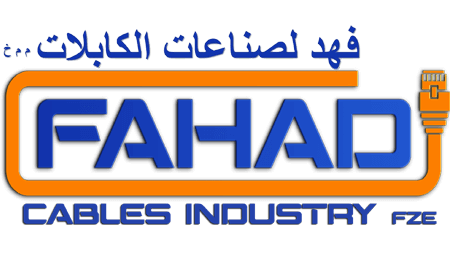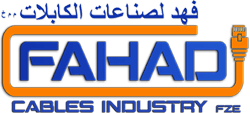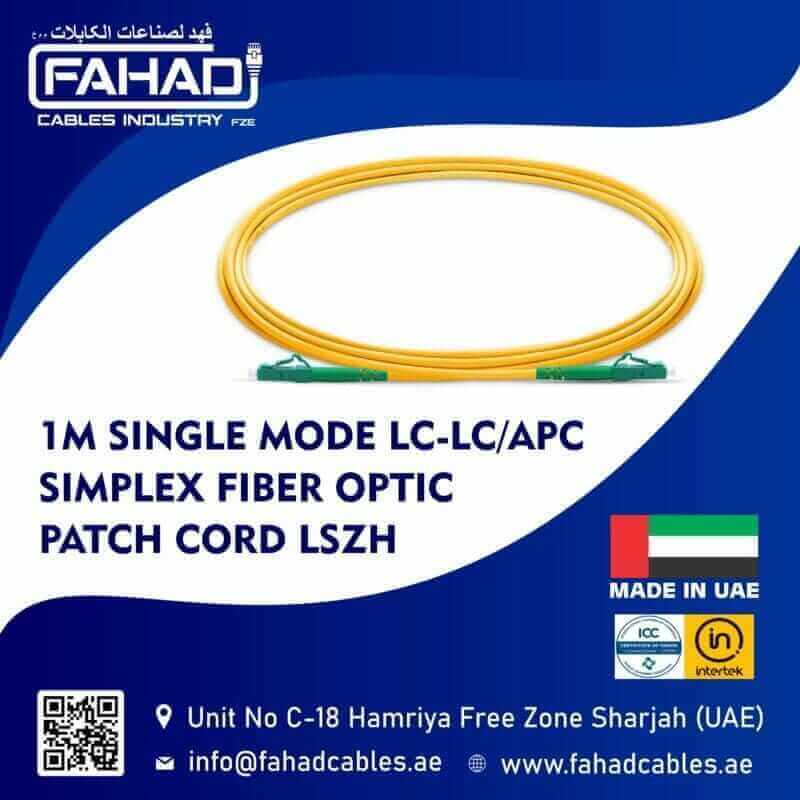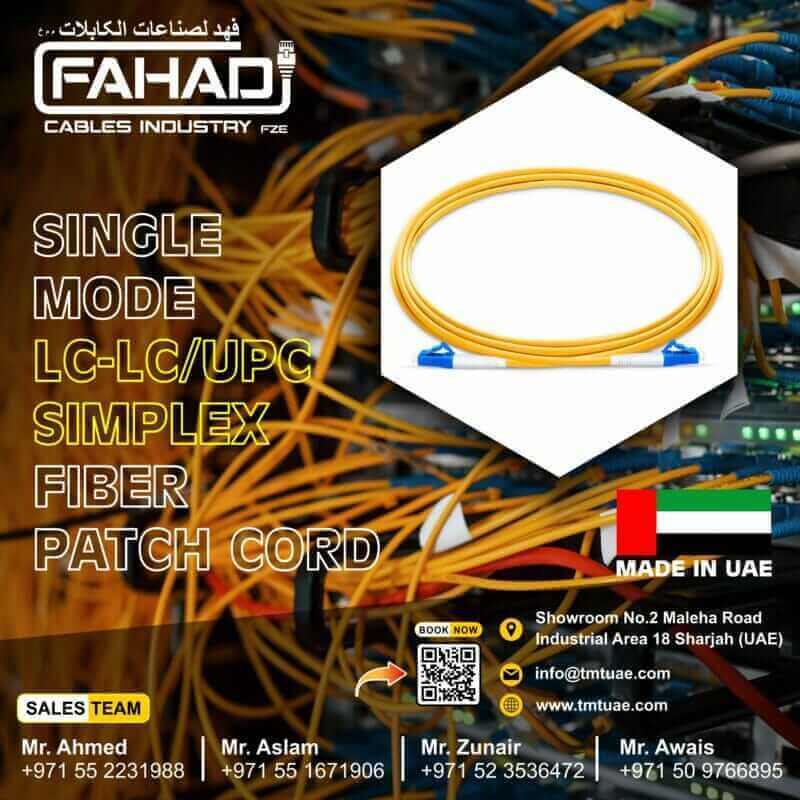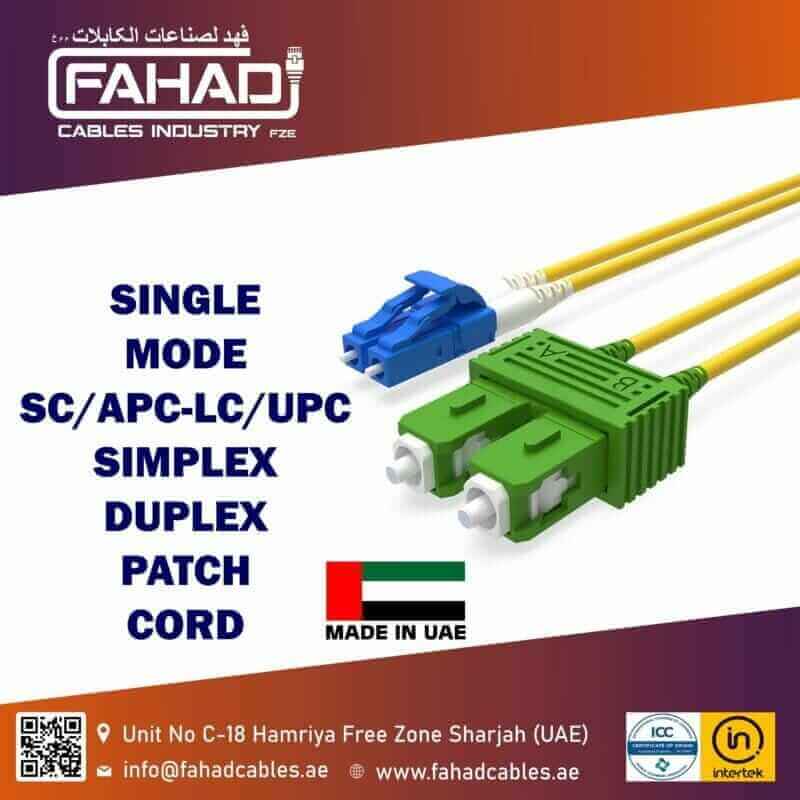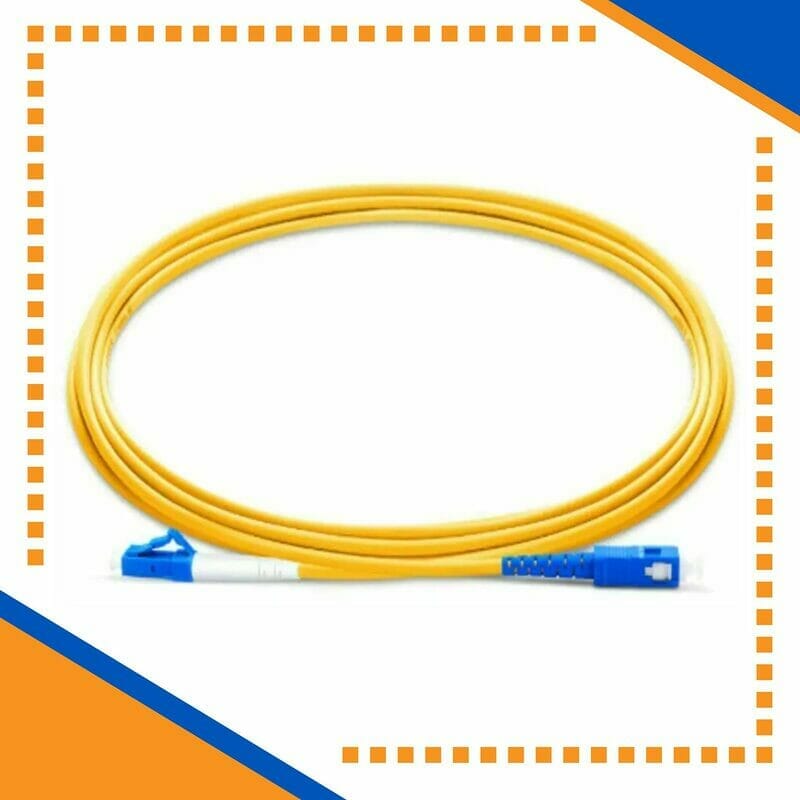- Network Cables
- Control automation Cables
- Data Patch Cord
- fiber optic cable
- Fiber Patch cord Multimode
- Fiber Patch cord Single Mode
- Fiber Pigtails Series
- Coaxial Cables
- security cable wire
- alarm cable
- speaker cables
Exploring the Features of Multimode LC Fiber Patch Cord OM3 LSZH UPC DX from Fahad Cables Industry FZE
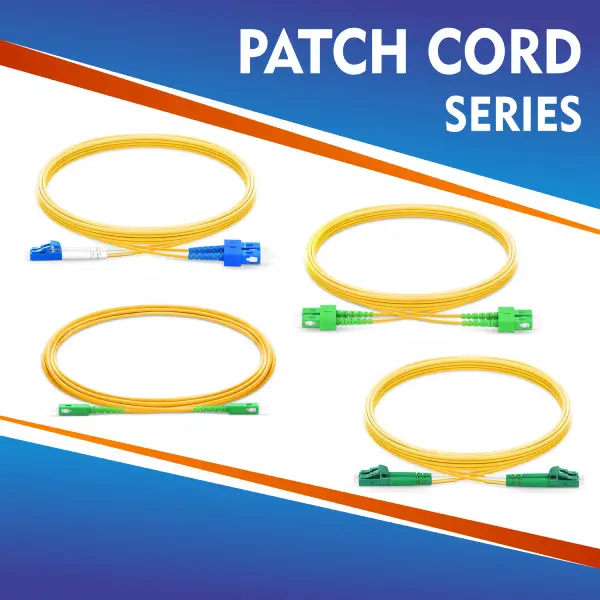
Introduction to Multimode Fiber Patch Cords
Multimode fiber patch cords are essential components in modern optical fiber networks, allowing for the transmission of data through multiple light paths within a single fiber. These cords utilize multimode fiber cables, which consist of a core with a larger diameter compared to single-mode fibers. This feature enables multiple modes or pathways for light to propagate simultaneously, which is particularly beneficial in short-distance applications.Multimode LC Fiber Patch Cord OM3
Typically, a multimode fiber patch cord is designed with a core diameter of 50 or 62.5 micrometers, allowing for effective light transmission over distances that can range from a few meters up to several hundred meters. The design enhances both the efficiency and capacity of data transmission, making them an excellent choice for various applications in telecommunications, data centers, and local area networks (LANs).
what is a characteristic feature of ultraphysical contact (upc) finishing type for fiber optic connectors?
In telecommunication setups, multimode fiber patch cords are commonly employed to connect various network devices, such as switches, routers, and servers. Their ability to transmit signals over short distances with low attenuation and high data throughput makes them ideal for use in high-speed networks. Additionally, the structure of multimode fibers significantly reduces the potential for signal loss, ensuring reliable connectivity.
Moreover, multimode fiber patch cords are often chosen for their versatility and compatibility with various connectors and transceivers, facilitating easy integration into existing network infrastructures. As data communication demands continue to grow, the importance of multimode fiber patch cords, especially in high-bandwidth environments, cannot be overstated. These cords not only enhance performance but also contribute to the overall robustness of optical fiber networks.
Understanding LC-LC Connections
The LC-LC connector is a key component in modern fiber optic communication, offering several advantages that make it a preferred choice for many applications. Its design features a small form factor, allowing for higher density connectivity compared to traditional connectors. This compact size is particularly beneficial in environments where space is at a premium, such as data centers and telecom rooms.
One of the primary benefits of the LC connector lies in its ease of handling. The design includes a simple latch mechanism that facilitates quick and secure connections. This feature enhances the installation process, allowing technicians to make efficient connections without the risk of damaging the fibers during handling. As a result, the LC-LC connections are not only more user-friendly but also contribute to reducing overall installation time.
In terms of performance, LC-LC connections exhibit remarkable reliability. They provide low insertion loss and excellent return loss, ensuring optimal signal integrity over long distances. This performance characteristic is essential in high-speed data transmission, where even minimal losses can result in significant data degradation. Furthermore, the LC connectors are engineered to provide stable and consistent performance across varying environmental conditions, ensuring that network operations remain uninterrupted.
Another important aspect to note is that LC connectors are compatible with both multimode and single-mode fibers. The patch cords offered by Fahad Cables Industry FZE, particularly the multimode LC-LC UPC DX Fiber Patch Cord, take full advantage of this versatility. By utilizing these connectors, users can seamlessly integrate different fiber types within their network setups, promoting flexibility in system design and implementation.
Overall, understanding the advantages of LC-LC connections is crucial for anyone involved in fiber optic networking. Their compact size, ease of use, and reliable performance make them an excellent choice for today’s high-density applications.
What is UPC DX Technology?
UPC DX technology pertains to a specialized type of connector utilized in fiber optic applications, specifically focusing on Ultra Physical Contact (UPC) connectors. These connectors are designed to enhance the performance of fiber optic links by minimizing the insertion loss—a critical measure of signal strength that can have a significant impact on overall network performance. In high-speed communication systems, even slight losses can result in degraded signal quality, leading to reduced data integrity and increased latency.
The design of UPC connectors incorporates a polished finish that allows for better contact between the connector and the fiber, which in turn reduces air gaps. This ensures that more light is transmitted through the fiber optic cord, thus enhancing the signal quality. The superior performance of UPC technology makes it particularly beneficial in high-speed applications where maintaining optimal data transmission rates is essential. Its capability to minimize reflectance also plays a crucial role in improving signal clarity during transmission, which is a vital factor in various communication systems.
Additionally, UPC technology is characterized by its robust build quality, which contributes to its longevity and reliability. As industries increasingly rely on faster and more efficient data transfer, the importance of incorporating high-performance components, such as UPC connectors, cannot be overstated. The advancements in UPC DX technology signify a step forward in meeting the evolving demands of modern fiber optic networks, ensuring they can support the growing bandwidth requirements across various applications, from telecommunications to data centers.
Importance of LSZH (Low Smoke Zero Halogen) Sheathing
The LSZH (Low Smoke Zero Halogen) material is a crucial feature in the construction of fiber patch cords, specifically the Multimode LC-LC UPC DX Fiber Patch Cord offered by Fahad Cables Industry FZE. This type of sheathing is designed to substantially reduce the emission of toxic and corrosive gases during combustion. In environments where fire safety is a significant concern, such as office buildings, schools, and healthcare facilities, LSZH sheathed cables provide enhanced protection for both individuals and equipment.
One of the primary benefits of LSZH sheathing is its remarkably low smoke generation. In the event of a fire, standard materials can produce hazardous smoke that obscures visibility and poses a serious risk to health. On the contrary, LSZH materials generate minimal smoke, ensuring that evacuation routes remain visible and reducing inhalation risks. This feature is especially vital in confined spaces where rapid smoke accumulation can accelerate the danger.
Moreover, LSZH sheathing complies with international safety standards, ensuring that installations meet critical regulations. Adherence to these standards not only secures the safety of users but also serves to protect the integrity of the fiber optic system. As the telecommunications industry places greater emphasis on environmental responsibility, the use of LSZH products aligns well with sustainable practices, reflecting a commitment to safety and environmental impact.
Ultimately, the incorporation of LSZH material in fiber patch cords is a proactive choice that balances high-performance functionality with significant safety benefits. By reducing toxicity and prioritizing safety, LSZH solutions, such as the OM3 Fiber Patch Cord from Fahad Cables Industry FZE, are particularly well-suited for indoor applications where performance and safety are paramount.
OM3 Fiber Specifications and Benefits
OM3 fiber, a variant of multimode fiber optic cables, is engineered to facilitate high-speed data transmission within networks. It predominantly operates at an 850 nm wavelength and adheres to stringent specifications that make it ideal for a variety of applications, particularly in data centers. One of the standout features of OM3 fiber is its bandwidth capability, which is rated at 2000 MHz·km. This impressive bandwidth supports high data rates, allowing for transmission speeds up to 10 Gbps over distances of up to 300 meters. Furthermore, OM3 can support even higher data rates, such as 40 Gbps and 100 Gbps, but over shorter distances of 100 meters.
Performance over distance is a critical aspect of OM3 fibers. With the ability to maintain signal integrity across considerable lengths, OM3 fibers are instrumental in large-scale installations such as data centers and enterprise networks. For instance, when deploying 10 Gigabit Ethernet, OM3 fibers can efficiently transmit data over the recommended lengths, ensuring that organizations can meet their bandwidth demands without degradation in performance.
Optimal applications for OM3 fibers include data centers, enterprise networks, and other environments where high data rates are required. These fibers play a crucial role in connecting servers and switches, allowing high-speed communications essential for modern digital operations. In addition, the use of OM3 fibers contributes to future-proofing network infrastructure, as they can easily accommodate growing data traffic and the increasing need for faster transmission speeds.
In addition to their outstanding technical specifications, OM3 fibers are also designed with low smoke zero halogen (LSZH) properties, making them safer in situations where fire safety is a concern. Overall, OM3 fiber optics provide an optimal blend of performance and safety, making them a preferred choice for many network architects and IT professionals.
Manufacturing Quality at Fahad Cables Industry FZE
Fahad Cables Industry FZE, located in Sharjah, UAE, has established itself as a leading manufacturer of high-quality fiber optics solutions, specifically the Multimode LC-LC UPC DX Fiber Patch Cord LSZH OM3. The manufacturing process at Fahad Cables is characterized by an unwavering dedication to quality control, ensuring that every product they produce meets stringent industry standards. This commitment to quality is evident in their meticulous approach to sourcing raw materials, where only the finest components are used to ensure optimal performance and durability of the fiber patch cords.
Utilizing advanced technology in their manufacturing operations, Fahad Cables stands out for integrating state-of-the-art machinery and equipment. This technological edge allows for precision in the production process, minimizing errors and enhancing the overall quality of the fiber optic products. The manufacturing facility is equipped with automated systems that not only increase efficiency but also guarantee consistent output quality. This careful blending of traditional craftsmanship with modern automation exemplifies their commitment to delivering superior solutions to their clientele.
Moreover, rigorous testing methods are implemented throughout the production cycle. Each Multimode LC-LC UPC DX Fiber Patch Cord undergoes comprehensive assessments to evaluate various performance metrics, including insertion loss, return loss, and optical performance. These tests are crucial to verify that the products can withstand real-world applications, offering reliability and longevity in high-demand environments. By adhering to international quality standards and protocols, Fahad Cables ensures that their fiber patch cords not only meet but exceed customer expectations, fortifying their reputation in the telecommunications industry.
Applications of LC-LC UPC DX Fiber Patch Cords
The LC-LC UPC DX fiber patch cord is integral to various sectors that require high-speed data transmission. One of its primary applications is in enterprise networking, where reliable and fast connections are essential for daily operations. Enterprises often rely on these patch cords to facilitate seamless communication between servers, switches, and routers, ensuring data flows efficiently across their networks.
In the telecommunications industry, the LC-LC UPC DX fiber patch cords serve a similar purpose, where they are utilized to connect different components of the transmission system. Their low insertion loss and high return loss characteristics make them ideal for supporting extensive telecommunication networks, ensuring that voice and data communications remain clear and uninterrupted.
Data centers are another significant application area for LC-LC UPC DX fiber patch cords. Given the increasing demand for cloud services and data processing capabilities, data centers require cables that can handle high bandwidth and minimize latency. These patch cords meet the demands of modern data centers by providing robust connections between storage area networks (SANs) and other networking equipment. The compact design of the LC-LC connectors also optimizes space, which is crucial in the densely populated environments of data centers.
In addition to these applications, LC-LC UPC DX fiber patch cords are increasingly used in educational institutions, research facilities, and healthcare organizations, where high-speed data transfer is necessary for transmitting large files and conducting video conferencing. Their flexibility and effectiveness in various environments enhance their utility across different sectors, highlighting the versatility of these fiber patch cords in today’s digital landscape.
Choosing the Right Patch Cord for Your Needs
When it comes to selecting the appropriate fiber patch cord for your installation, several critical factors must be considered to ensure optimal performance and long-term efficiency. The choice of a fiber patch cord, such as the multimode LC-LC UPC DX type from Fahad Cables Industry FZE, requires a thorough understanding of your specific networking requirements, including factors such as distance, bandwidth needs, connector types, and environmental considerations.
Firstly, the distance between your devices plays a pivotal role in determining the type of patch cord you should choose. It’s essential to select a fiber patch cord that can effectively handle the required transmission distance without significant signal loss. For instances involving longer runs, such as between floors in a building, the OM3 multimode fiber patch cord is well suited as it permits efficient signal transmission with minimal attenuation.
Next, understanding your bandwidth needs is crucial. The OM3 multimode fiber patch cord is designed to support higher bandwidths, making it an ideal choice for data-intensive applications. It is critical to assess not only the current needs but also future requirements, as network demands may expand over time. This foresight can prevent the need for premature replacements.
Additionally, the type of connectors is another significant consideration. The LC connectors on the patch cord are compact and efficient, facilitating high-density installations. Comprehending the compatibility of these connectors with existing equipment is essential to avoid integration issues.
Finally, environmental factors such as temperature, moisture, and physical stress must also be taken into account. Selecting a patch cord that includes Low Smoke Zero Halogen (LSZH) materials ensures compliance with safety standards while offering resistance to environmental hazards.
Making an informed decision regarding the selection of the right fiber patch cord will lead to enhanced network performance and reliability, addressing all necessary requirements effectively.
Conclusion and Future Trends in Fiber Optic Technology
The evolution of fiber optic technology has significantly transformed the telecommunications landscape, especially with innovations such as the Multimode LC-LC UPC DX Fiber Patch Cord LSZH OM3 from Fahad Cables Industry FZE. Throughout this blog post, we have explored the essential features and benefits of high-quality fiber patch cords, emphasizing their critical role in establishing reliable and efficient networks. The UPC style of this fiber patch cord, combined with its low smoke zero halogen (LSZH) jacket, not only enhances the performance but also ensures safety in various environments, making it an ideal choice for modern data centers and telecommunication systems.
As the demand for faster data transmission and higher bandwidth escalates, the significance of reliable fiber patch cords cannot be overstated. These cords facilitate seamless connectivity between components, ensuring that organizations can meet their growing data needs without compromising on quality. Furthermore, the OM3 multimode specification aids in multi-gigabit applications while maintaining exceptional signal integrity over longer distances. The advantages of these fiber patch cords align with the ongoing trends toward 5G deployment and the expansion of internet infrastructure globally.
Looking ahead, the fiber optic industry is poised for further advancements that could change the future of networking. Technologies such as dense wavelength division multiplexing (DWDM) and improvements in ribbon fiber technology are likely to emerge, enhancing the capabilities of fiber patch cords. Additionally, we may witness innovations in materials and manufacturing processes that improve performance characteristics while reducing costs. As we continue to embrace digital transformation, staying informed about these trends and advancements will be crucial for businesses looking to invest in robust networking solutions to support their operations.
